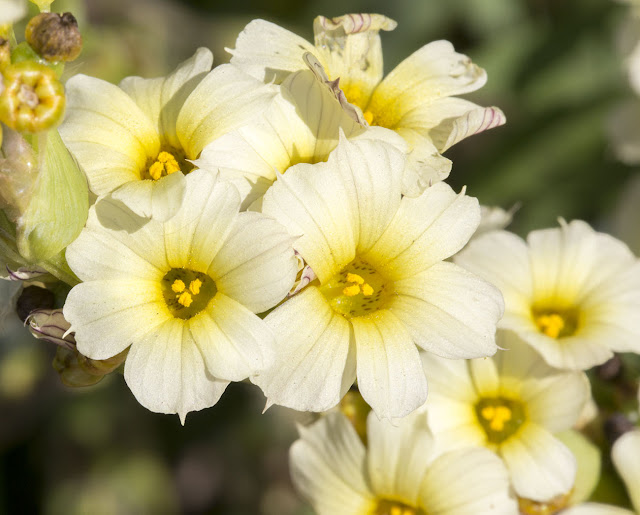 |
| White Bryony, Bryonia dioica. Female. Hayes, 18 June 2015. |
 |
| White Bryony, Bryonia dioica. Male. Hayes, 20 June 2015. |
This White Bryony was in the hedgerow at the edge of Hayes churchyard. It's a common hedgerow plant, a climber, related to cucumbers, and each plant is single-sexed. They are not showy, but are beautiful in detail.
 |
| Snapdragon, Antirrhinum majus. On Hayes churchyard wall. 18 June 2015. |
The wall that separates the churchyard from the road has an excellent flora of its own. I would not have thought that a garden plant like a Snapdragon could flourish unattended with nothing but a crack in the stonework for its roots. At the base of the Snapdragon you can also see a small Rustyback Fern, quite a rarity in Kent, and to the right is a Harebell, this one not in flower.
 |
| Pale Yellow-eyed Grass, Sisyrinchium striatum. Hayes Street Farm, 18 June 2015. |
Back at the farm, I found this Pale Yellow-eyed Grass in an unattended corner. It took me some while to identify it. It's not in the book I use most of the time because it's only found in the wild "naturalised, often short-lived, on tips, waste ground, banks and waysides," which describes where I found it quite well. With leaves like an Iris (to whose family it belongs) but flowers like no Iris ever, I found it after a long Googling session! The flowers are:
 |
| Pale Yellow-eyed Grass, Sisyrinchium striatum. Hayes Street Farm, 18 June 2015. |
Light yellow with darker centres.
 |
| Peacock larvae, Aglais io, on Common Nettle, Urtica dioica. Hayes Street Farm, 18 June 2015. |
I was looking through a large stand of stinging nettles nearby, watching for damselflies, when I spotted these caterpillars. They belong to the Peacock butterfly and they are immediately identifiable by their host plant and their habit of cocooning it up, and those black spines along their backs.
 |
| White Campion, Silene latifolia. Hayes Street Farm. 18 June 2015. |
And last for today, also on the farm, near the Clustered Dock I showed last time, was this White Campion. I was pleased to add this to my species list. The Red Campion is common in the local woods, but I see this relative much less often.
The more I walk around my monads with open eyes, the more interesting things I find - and all 15 or 20 minutes' walk from my door.







No comments:
Post a Comment